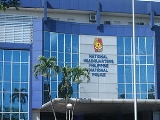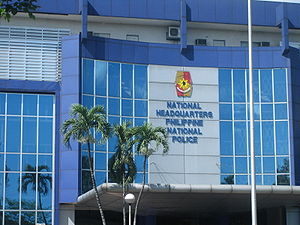
Camp Crame
Encyclopedia

Headquarters
Headquarters denotes the location where most, if not all, of the important functions of an organization are coordinated. In the United States, the corporate headquarters represents the entity at the center or the top of a corporation taking full responsibility managing all business activities...
of the Philippine National Police
Philippine National Police
The Philippine National Police is the national police force of the Republic of the Philippines. It is both a national and a local police force in that it does provides all law enforcement services throughout the Philippines...
(PNP) and is located in along Epifanio de los Santos Avenue
Epifanio de los Santos Avenue
Epifanio de los Santos Avenue , formerly known as Highway 54, is the main circumferential road and highway of Metro Manila in the Philippines. It is an important commuting artery between the northern and southern parts of the metropolitan area...
, Quezon City
Quezon City
Quezon City is the former capital and the most populous city in the Philippines. Located on the island of Luzon, Quezon City is one of the cities and municipalities that make up Metro Manila, the National Capital Region. The city was named after Manuel L...
. Formerly the national headquarters of the Philippine Constabulary
Philippine Constabulary
The Philippine Constabulary ' was the oldest of four service commands of the Armed Forces of the Philippines. It was a gendarmerie type para-military police force of the Philippines established in 1901 by the United States-appointed administrative authority replacing the Guardia Civil...
, Camp Crame is located across the street from Camp Aguinaldo
Camp Aguinaldo
Camp Aguinaldo is the military headquarters of the Philippine Army and the Armed Forces of the Philippines and is located in Quezon City in the Philippines. It is along Epifanio de los Santos Ave. , in front of Camp Crame, the national headquarters of the Philippine National Police...
, the national headquarters of the Armed Forces of the Philippines
Armed Forces of the Philippines
The Armed Forces of the Philippines is composed of the Philippine Army, Philippine Navy and Philippine Air Force...
.
It was named after the first Filipino Chief of the Philippine Constabulary
Philippine Constabulary
The Philippine Constabulary ' was the oldest of four service commands of the Armed Forces of the Philippines. It was a gendarmerie type para-military police force of the Philippines established in 1901 by the United States-appointed administrative authority replacing the Guardia Civil...
, Brigadier General Rafael Cramé.
History
As early as the 1930s, military facilities were set up in Quezon City, among them Camp Murphy (now Camp Aguinaldo) and Camp Crame. Named after the first Filipino brigadier general of the Philippine Constabulary (PC), Rafael Crame, the camp was where the General Strike Force of the PC was organized under Brig. Gen. Guillermo Francisco in 1939.Camp Crame had been used as the headquarters of the Philippine Constabulary, which was then considered part of the Armed Forces of the Philippines (AFP). A major detention area during the Marcos dictatorship, it became one of the rallying points of people during the EDSA Revolution of 1986.
Today, the camp is now the headquarters of the Philippine National Police, established in 1991 as an entity separate from the AFP. However, despite this separation, the titles to the land which Camp Crame stands were only turned over to the PNP by the AFP in July 2008.
The camp is currently undergoing renovation, starting with the renovation of the PNP Multipurpose Hall and the camp's swimming pool. There are also plans for the construction of a multi-storey building along the EDSA side of the camp to house the administrative offices of the PNP, as well as commercial establishments for the general public.
Several high-profile personalities have been detained at Camp Crame in recent years, among them deposed President Joseph Ejercito Estrada. The ongoing trial for the Maguindanao Massacre is also held in a courtroom inside the camp, where primary suspect Datu Unsay mayor Andal Ampatuan Jr. is being detained.

